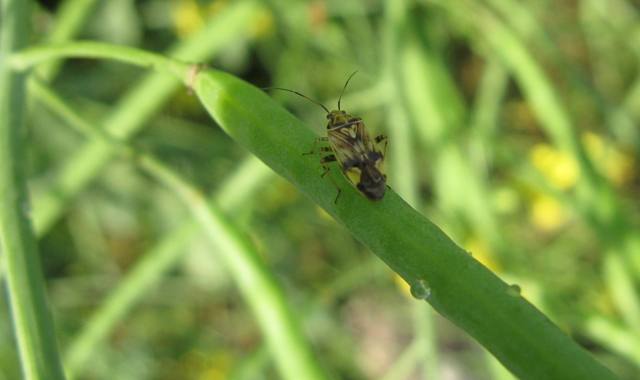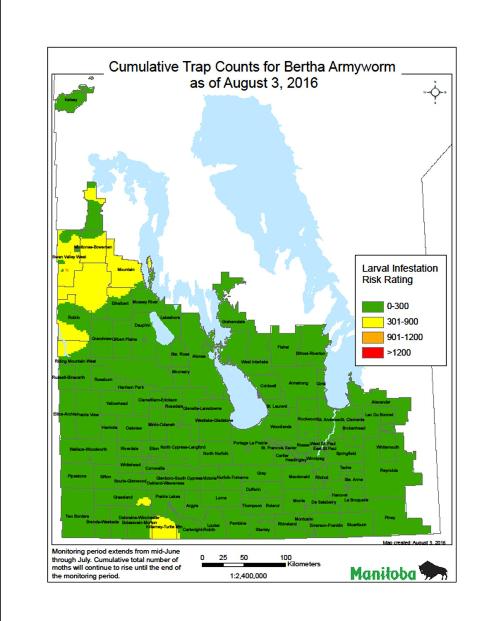Manitoba Insect & Disease Update
Issue 12: August 3, 2016
Summary
Insects: Insects of highest importance to scout for currently are Lygus bugs in canola and sunflowers, and banded sunflower moths in sunflowers. Only trace levels of soybean aphids have been found so far. Although a couple of traps monitoring adults of bertha armyworm had moderate counts in the Northwest, and a few traps had counts in the uncertain risk range, there have been no reports of high levels of larvae of bertha armyworms so far.
Plant Pathogens: Disease surveys for field crops are progressing rapidly and various diseases continue to be reported.
Disease update
Oilseeds: Sclerotinia is being reported in canola, sunflower and flax.
Canola: Root rots due to Fusarium spp and Rhizoctonia spp were reported at Manitoba Agriculture’s Crop Diagnostic lab. Blackleg is also being reported.
Corn: Common rust was found in low incidence in some corn fields. Goss’s wilt is also being found in some fields.
Soybeans: Sclerotinia, downy mildew and brown spot continue to be reported in soybeans.
Crop Stages most sensitive to Lygus Bugs in canola
It is the early podding stage of canola that are most sensitive to potential damage from Lygus bugs. With adequate soil moisture, plants will compensate well for loss of flowers. It is feeding directly to seeds when the seeds are young that has the highest potential to reduce yields if levels of Lygus bugs are high enough.
At the current value of canola and control costs (assuming about $10.00 / bushel for canola) the economic threshold will be in the range of 10 to 15 Lygus bugs per 10 sweeps when the seeds in the lower pods are enlarging to full-size and translucent. When seeds in the lower pods are green the economic threshold would be about 15 to 20 Lygus bugs in 10 sweeps.
Once canola has reached the R5.3 stage, where seeds in the lower pods are mottled green-brown, the seeds are mature enough that Lygus bugs are no longer considered an economic risk. There are no economic thresholds for Lygus bugs in canola at the R5.3 stage and beyond.
Once canola has reached the R5.3 stage, where seeds in the lower pods are mottled green-brown, the seeds are mature enough that Lygus bugs are no longer considered an economic risk. There are no economic thresholds for Lygus bugs in canola at the R5.3 stage and beyond.

Figure 1. Lygus bug on canola pod.
A vigorously growing canola crop can be very difficult to walk through and sweep when it gets into the podding stage. If this is the case, samples can be collected from along the edge or at right angles from the edge of the field. Research has shown that samples taken along the edge of commercial fields and at various distances into the field all gave similar estimates of plant bug density. Sampling along the edge reduces effort during years when thick crop growth impedes access to the field. For edge sampling, the area selected for sampling should be at a crop stage similar to that in the main part of the field.
Insect Monitoring Programs
Grasshopper Survey: Manitoba, Saskatchewan and Alberta have for many years surveyed grasshopper populations in August to predict the regional risk from grasshoppers the following year. The data is mapped, and this forecast is used by farmers, agronomists, and agricultural retailers to plan for the following season.
A reminder for those participating in the grasshopper survey, that counts are done during August, when the majority of grasshoppers are in the adult stage. Agronomists and farmers who would also be interested in estimating grasshopper numbers in the fields they are in and have this information included in the survey are encouraged to see the survey protocol for more details of the survey and where to send data. Estimates of grasshopper levels can be collected during regular farm visits.
"Estimates" of grasshopper populations is stressed as it will not be possible to accurately count grasshoppers along a field edge or ditch area as they will be moving around as you get near the area of the count. But estimate of what is present gives us some idea of the relative numbers that are present in different areas.
Data from the survey, along with weather data during the egg laying period of the grasshoppers, is used to produce a forecast for 2017.
The protocol and data sheet for the grasshopper survey is at: http://www.gov.mb.ca/agriculture/crops/insects/mb-grasshopper-survey.html
A reminder for those participating in the grasshopper survey, that counts are done during August, when the majority of grasshoppers are in the adult stage. Agronomists and farmers who would also be interested in estimating grasshopper numbers in the fields they are in and have this information included in the survey are encouraged to see the survey protocol for more details of the survey and where to send data. Estimates of grasshopper levels can be collected during regular farm visits.
"Estimates" of grasshopper populations is stressed as it will not be possible to accurately count grasshoppers along a field edge or ditch area as they will be moving around as you get near the area of the count. But estimate of what is present gives us some idea of the relative numbers that are present in different areas.
Data from the survey, along with weather data during the egg laying period of the grasshoppers, is used to produce a forecast for 2017.
The protocol and data sheet for the grasshopper survey is at: http://www.gov.mb.ca/agriculture/crops/insects/mb-grasshopper-survey.html
Bertha armyworm: Cumulative trap counts for bertha armyworm are mainly in the low risk range (less than 300). Out of 83 traps, 71 are in the low risk range, 10 are in the uncertain risk range (300 to 900 moths), and 2 traps are in the moderate risk range (900 - 1,200 moths). No traps are in the high risk range (1,200 plus moths). Most of the counts above the low risk range are in the western regions of Manitoba. The table below shows the highest counts as of July 30 (end of final week of trapping):
Cumulative trap counts for bertha armyworm
0-300=low risk 300-900=uncertain risk 900-1,200=moderate risk 1,200+=high risk | |
|---|---|
| Location | Count Risk |
| Durban (NW) | 1,116 Moderate |
| Benito (NW) | 938 Moderate |
| Lena (C) | 530 Uncertain |
| Kenville (NW) | 462 Uncertain |
| Minto (SW) | 447, 363 Uncertain |
| Roblin (NW) | 408 Uncertain |
| Tummel (NW) | 399 Uncertain |
| Swan Valley (NW) | 386, 356 Uncertain |
| Dunrea (C) | 336 Uncertain |
In the map below, green=low risk, yellow=uncertain risk, and orange=moderate risk

A reminder for those monitoring traps that the monitoring period for adult moths is now done and traps can be pulled.
While scouting canola fields, it is advised to check the ground for larvae and assess plants for signs of potential feeding by bertha armyworm, particularly in western Manitoba.
Note that there are times when we get to these levels, and no economic levels of larvae occur.
Also, higher levels of larvae, should they occur, may or may not be in the fields that the traps are in.
Also, higher levels of larvae, should they occur, may or may not be in the fields that the traps are in.
So far there have been no reports of high levels of larvae of bertha armyworms.
A more detailed forecast for bertha armyworm is posted at:
Compiled by:
John Gavloski, Entomologist Pratisara Bajracharya, Field Crop Pathologist
Manitoba Agriculture Manitoba Agriculture
Phone: (204) 745-5668 Phone: (204) 750-4248
To report observations on insects or plant pathogens that may be of interest or importance to farmers and agronomists in Manitoba, please send messages to the above contacts.
To be placed on an E-mail list so you will be notified immediately when new Manitoba Insect and Disease Updates are posted, please contact John Gavloski at the address or numbers listed above.
